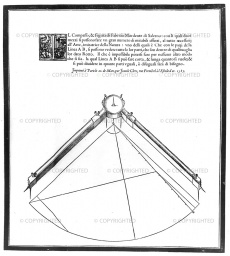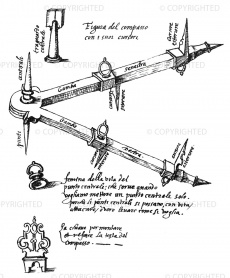Eight-Point Compasses
From Inventions
| (11 intermediate revisions not shown) | |||
| Line 1: | Line 1: | ||
{{Template invention | {{Template invention | ||
| - | |nome= | + | |nome= |
| + | Name documented by Milles Denorry ("Compas à huict Poinctes") in 1588. | ||
|inventore= Fabrizio Mordente (1532-1608?) | |inventore= Fabrizio Mordente (1532-1608?) | ||
| Line 7: | Line 8: | ||
|data= 1585 | |data= 1585 | ||
| - | |descrizione= | + | |descrizione= |
| - | + | Fourth version of the so-called [["Compasso Magistrale" (Masterly Compasses) | "compasso magistrale" (masterly compasses)]] described by Fabrizio Mordente in a broadsheet printed in Paris in 1585 entitled ''Il Compasso e Figura di Fabritio Mordente....'' [The Compass and Figure of Fabrizio Mordente…]. Hoping to obtain a position at the court of Henry III, Mordente gave various public demonstrations of his compass. Giordano Bruno was present at one of these demonstrations. Fascinated by the invention, he decided to compose two dialogues to disclose the hermetic secrets of the compass, developing his first reflections on the nature of the minimum. The ''Dialogi duo'' [Two dialogues] (Paris 1586) brought the compass to the attention of the scientific world, but cast a shadow of infamy on Mordente, who was suspected of plagiarism. Mordente publicly denounced the arrogance of Bruno, who wrote another two dialogues in which the "god of geometers", as he had called Mordente in the previous dialogues, was scornfully portrayed as the "Triumphant Idiot" (''Idiota Triumphans…''). After this violent argument, the mathematician Milles Denorry published a treatise on the compasses, ''L’usage et pratique du Compas à huict Poinctes'' [The use and operation of the eight-point compasses] (1588), popularizing the name of 8-point compass. The compasses was composed of two slender square-section legs along which slid four cursors with points orthogonal to the legs. Of the other four points, two were on the ends of the legs and two at the hinged joint. The compasses was always used with a particular geometric figure, a quadrant, to carry out proportional operations and measure fractions of degrees. | |
|componenti= | |componenti= | ||
| Line 24: | Line 25: | ||
| - | |strumentiesistenti= Chicago, Adler Planetarium, M-67b | + | |strumentiesistenti= |
| + | |||
| + | - Adler Planetarium, Chicago <br> | ||
| + | [http://www.adlerplanetarium.org/4dlink/4DACTION/webserveimage?M-67b Chicago, Adler Planetarium, inv. M-67b]<br> | ||
| + | |||
|link= | |link= | ||
| + | |||
| + | http://www.nicolaseverino.it/Articoli/Il_compasso_di_proporzione.pdf (Italian) | ||
|immagini= <gallery widths=230 heights=368 perrow=3> | |immagini= <gallery widths=230 heights=368 perrow=3> | ||
Image: 0050-40308.jpg| Fabrizio Mordente. ''Il compasso e Figura di Fabritio Mordente''. Parigi, 1585.<br /> | Image: 0050-40308.jpg| Fabrizio Mordente. ''Il compasso e Figura di Fabritio Mordente''. Parigi, 1585.<br /> | ||
| - | Image: | + | |
| + | Image: 56694.jpg| Michel Coignet. ''L'uso del compasso di Fabritio Mordente''. ms., 1608, Modena, Biblioteca Estense, Gamma U.1.18- Campori 209, il compasso di Mordente.<br /> | ||
| + | |||
| + | Image: 56695-Compasso_8_punte_p111_1000.jpg| Michel Coignet. ''L'uso del compasso di Fabritio Mordente''. ms., 1608, Modena, Biblioteca Estense, Gamma U.1.18, c. 2v, il compasso di Mordente nell'uso topografico.<br /> | ||
| + | |||
</gallery> | </gallery> | ||
Current revision as of 08:14, 10 September 2010
Name documented by Milles Denorry ("Compas à huict Poinctes") in 1588.
Contents |
Inventor
Fabrizio Mordente (1532-1608?)
Historic Period
1585
Description
Fourth version of the so-called "compasso magistrale" (masterly compasses) described by Fabrizio Mordente in a broadsheet printed in Paris in 1585 entitled Il Compasso e Figura di Fabritio Mordente.... [The Compass and Figure of Fabrizio Mordente…]. Hoping to obtain a position at the court of Henry III, Mordente gave various public demonstrations of his compass. Giordano Bruno was present at one of these demonstrations. Fascinated by the invention, he decided to compose two dialogues to disclose the hermetic secrets of the compass, developing his first reflections on the nature of the minimum. The Dialogi duo [Two dialogues] (Paris 1586) brought the compass to the attention of the scientific world, but cast a shadow of infamy on Mordente, who was suspected of plagiarism. Mordente publicly denounced the arrogance of Bruno, who wrote another two dialogues in which the "god of geometers", as he had called Mordente in the previous dialogues, was scornfully portrayed as the "Triumphant Idiot" (Idiota Triumphans…). After this violent argument, the mathematician Milles Denorry published a treatise on the compasses, L’usage et pratique du Compas à huict Poinctes [The use and operation of the eight-point compasses] (1588), popularizing the name of 8-point compass. The compasses was composed of two slender square-section legs along which slid four cursors with points orthogonal to the legs. Of the other four points, two were on the ends of the legs and two at the hinged joint. The compasses was always used with a particular geometric figure, a quadrant, to carry out proportional operations and measure fractions of degrees.
Bibliographical Resources
Bruno, Giordano. Dialogi duo de Fabricii Mordentis Salernitani propre divina adinventione ad perfectam cosmimetriae praxim, Parigi 1586.
Bruno, Giordano. Idiota Triumphans, De somnii interpretatione, Mordentius, De Mordentij circino, Parigi 1586.
Camerota, Filippo. Il Compasso di Fabrizio Mordente. Per la storia del compasso di proporzione, Firenze 2000.
Denorry, Milles. L’usage et pratique du Compas à huict Poinctes, Paris 1588.
Mordente, Fabrizio. Il Compasso e Figura di Fabritio Mordente..., Paris 1585.
Existing Instruments
- Adler Planetarium, Chicago
Chicago, Adler Planetarium, inv. M-67b
Links (External)
http://www.nicolaseverino.it/Articoli/Il_compasso_di_proporzione.pdf (Italian)
Images
Author of the entry: Filippo Camerota



